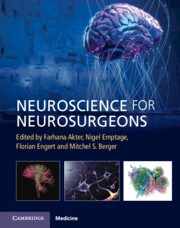Book contents
- Neuroscience for Neurosurgeons
- Neuroscience for Neurosurgeons
- Copyright page
- Contents
- Contributors
- Section 1 Basic and Computational Neuroscience
- Section 2 Clinical Neurosurgical Diseases
- Chapter 12 Glioma
- Chapter 13 Brain Metastases: Molecules to Medicine
- Chapter 14 Benign Adult Brain Tumors and Pediatric Brain Tumors
- Chapter 15 Biomechanics of the Spine
- Chapter 16 Degenerative Cervical Myelopathy
- Chapter 17 Spondylolisthesis
- Chapter 18 Radiculopathy
- Chapter 19 Spinal Tumors
- Chapter 20 Acute Spinal Cord Injury and Spinal Trauma
- Chapter 21 Traumatic Brain Injury
- Chapter 22 Vascular Neurosurgery
- Chapter 23 Pediatric Vascular Malformations
- Chapter 24 Craniofacial Neurosurgery
- Chapter 25 Hydrocephalus
- Chapter 26 Peripheral Nerve Injury Response Mechanisms
- Chapter 27 Clinical Peripheral Nerve Injury Models
- Chapter 28 The Neuroscience of Functional Neurosurgery
- Chapter 29 Neuroradiology: Focused Ultrasound in Neurosurgery
- Chapter 30 Magnetic Resonance Imaging in Neurosurgery
- Chapter 31 Brain Mapping
- Index
- References
Chapter 21 - Traumatic Brain Injury
from Section 2 - Clinical Neurosurgical Diseases
Published online by Cambridge University Press: 04 January 2024
- Neuroscience for Neurosurgeons
- Neuroscience for Neurosurgeons
- Copyright page
- Contents
- Contributors
- Section 1 Basic and Computational Neuroscience
- Section 2 Clinical Neurosurgical Diseases
- Chapter 12 Glioma
- Chapter 13 Brain Metastases: Molecules to Medicine
- Chapter 14 Benign Adult Brain Tumors and Pediatric Brain Tumors
- Chapter 15 Biomechanics of the Spine
- Chapter 16 Degenerative Cervical Myelopathy
- Chapter 17 Spondylolisthesis
- Chapter 18 Radiculopathy
- Chapter 19 Spinal Tumors
- Chapter 20 Acute Spinal Cord Injury and Spinal Trauma
- Chapter 21 Traumatic Brain Injury
- Chapter 22 Vascular Neurosurgery
- Chapter 23 Pediatric Vascular Malformations
- Chapter 24 Craniofacial Neurosurgery
- Chapter 25 Hydrocephalus
- Chapter 26 Peripheral Nerve Injury Response Mechanisms
- Chapter 27 Clinical Peripheral Nerve Injury Models
- Chapter 28 The Neuroscience of Functional Neurosurgery
- Chapter 29 Neuroradiology: Focused Ultrasound in Neurosurgery
- Chapter 30 Magnetic Resonance Imaging in Neurosurgery
- Chapter 31 Brain Mapping
- Index
- References
Summary
Traumatic brain injury(TBI) is one of the leading causes of morbidity and mortality worldwide, with an estimated annual incidence of 69 million individuals worldwide. In 2014, the CDC documented 2.5 million TBI-related emergency department visits in the United States with 288,000 TBI-related hospitalizations and 56,800 TBI-associated mortalities. Furthermore, TBI is the leading cause of long-term disability in children and young adults within the US population, with annual cost estimates in patients suffering from TBI varying from $56 billion to $221 billion.
- Type
- Chapter
- Information
- Neuroscience for Neurosurgeons , pp. 291 - 299Publisher: Cambridge University PressPrint publication year: 2024



